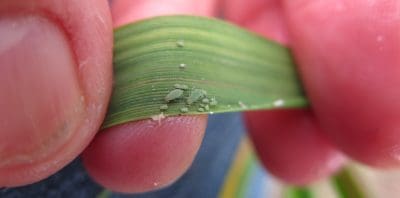GRAIN growers and agronomists in NSW and Queensland will need to be actively ‘searching and detecting’ for pests this winter, rather than just monitoring crops, according to Queensland Department of Agriculture and Fisheries (DAF) entomologist, Melina Miles.
The call for increased vigilance is due to the potential spread of the high priority pest, Russian Wheat Aphid (RWA), as well as growing awareness of the benefits of early detection in protecting yield when it comes to insect pests, like winter cereal aphids and green mirids in faba beans.
Speaking at Grains Research and Development Corporation (GRDC) updates in Queensland and NSW, Dr Miles said growers and advisors needed to be alert and ready to take action to reduce the profit risk of insect pests, particularly RWA.
She said while RWA had not yet been detected north of Rankin Springs in the Riverina of NSW, vigilance was required to ensure early detection of further outbreaks in the northern grain growing region.
“RWA is a high priority pest because of its potential to cause significant yield losses in wheat and barley if not well managed. Triticale and rye are also susceptible but oats are considered relatively resistant,” Dr Miles said.
“It is inevitable that RWA will establish in the northern grains region, but we don’t know when we will start to see it in crops, so it is critical that crops are monitored more frequently during the 2017 season in case it does occur this year.
“Growers should sample for the RWA in the same way they do for other cereal aphids. Concentrate on the field margins and in areas of the paddock which are stressed, looking for both the symptoms and presence of aphids.”
Key symptoms include striking symptoms in wheat and barley, rolled leaves or rolling of the flag leaf. Plant damage is in response to direct aphid feeding, so only the leaves and/or tillers infested show symptoms.
Should control of RWA be needed, an Emergency Use Permit (APVMA PER82792) is in place for chlorpyrifos and pirimicarb and is valid until June 2018.
Pirimicarb will kill aphids but not the beneficial insects in the crop so should be used in the first case, as the beneficials may suppress further outbreaks.
“Meanwhile, other things to watch for are winter cereal aphids, which can be managed successfully, with nominal thresholds and an understanding of their damage potential,” Dr Miles said.
“Field trials attempting to determine the impact aphids have on winter cereals over the past ten years and proven extremely difficult, but a combination of some Northern Grower Alliance work and some glasshouse trials, whilst not being able to confirm an economic threshold, has been useful in developing a greater understanding of the aphids and a reasonable approach to management.
“Weather, crop conditions and natural enemies all play a role in influencing aphid numbers. The damage potential of aphids in cereals seems to be based on the relationship between crop stage at infestation, density and duration of infestation.”
Seed treatment is an option for districts where aphid pressure is high in most seasons, although the use of neonicotinoid seed dressing poses some risks to the build-up of natural enemies and potential insecticide resistance.
It’s also worth noting the potential impact of late infestations on yield, particularly from grain-fill on, is low. The exception is RWA where infestations from stem elongation can prevent heads from emerging normally and impact on grain set and filling.
“The other research we have undertaken is to understand conclusively whether mirid feeding cause spotting on the seed, and hence if mirids warranted further research as a faba bean pest,” Dr Miles said.
“We have found that green mirids do cause spotting on faba bean seed and impact on seed size and yield. Both adult and late instar nymphs are damaging and warrant control in faba beans crops.
“All of these pests directly relate back to growers yield and profits, so continuous monitoring and detection is certainly one of the keys to a bumper season.”
For more detail on this research, go to Dr Miles’ Research Update paper https://grdc.com.au/Research-and-Development/GRDC-Update-Papers/2017/02/Aphids-and-other-green-profit-suckers.
Information on RWA preparedness, specifically for the northern region, is available on the Beatsheet blog http://thebeatsheet.com.au/
Source: GRDC



HAVE YOUR SAY